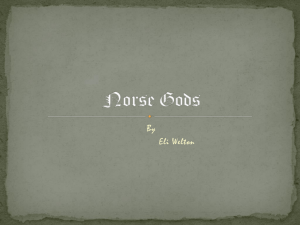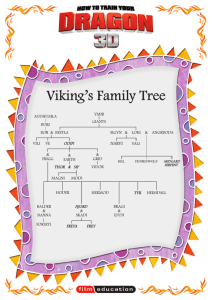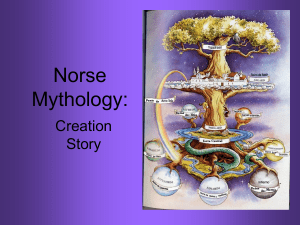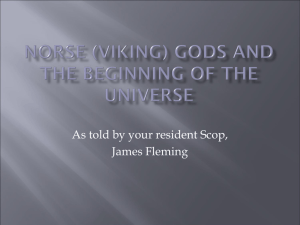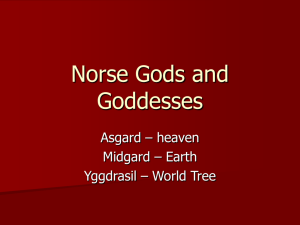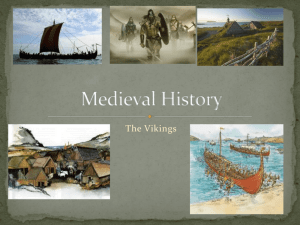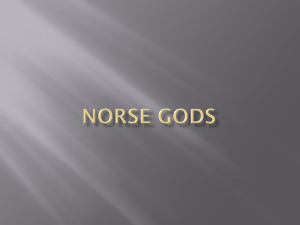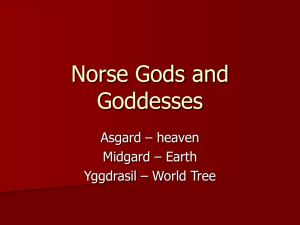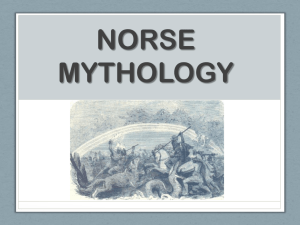Norse Myth - People Server at UNCW
advertisement
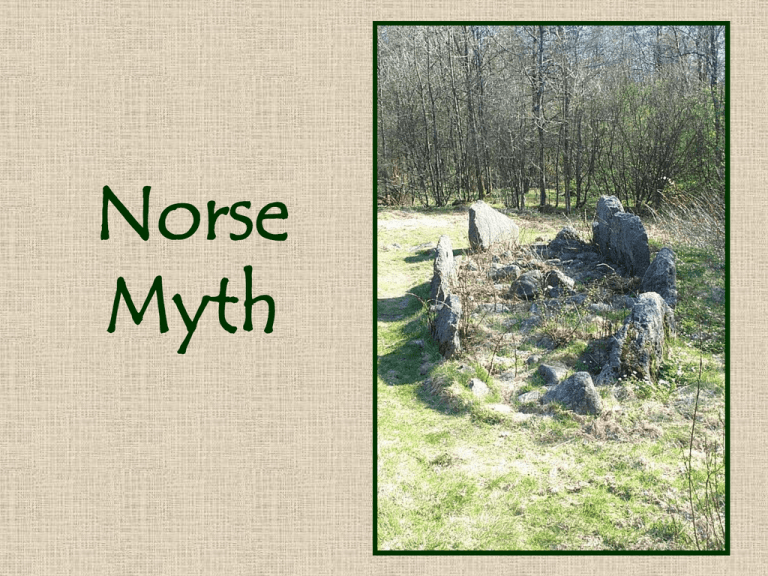
Norse
Myth
Sources
Norse myths existed only in oral form while they were central to
religious belief. They were only written down after Northern
Europe had become Christian.
So we have new problems with our primary sources:
•no coherent body of literature showing the myths and legends
•possible alteration due to the influence of Christianity
•“fictionalization” of stories which originally had religious
importance.
Plus:
•a wide time span, wide geographical range and many different
sub-cultures
Sources
Snorri Sturlesson: The Prose
Edda. A narrative of many
different adventures of the
Norse gods, but presented as
a fictional account,
sometimes almost
humorous. The closest we
have to an overview/
collection of Norse myth,
but often untraditional, and
very engaged with
intellectual & Christian
traditions (e.g., he connects
Thor with Troy).
Sources
Poetic Eddas: Traditional
songs, which often refer to
mythic incidents, usually just
individual adventures.
Skaaldic songs: poems in
honor of human
accomplishments, with
occasional references to myth,
sometimes very cryptic.
The Gods
The Norse gods are divided
into two races: Aesir and
Vanir.
Aesir are dominant; they
are the gods most associated
with heroic tales, conflict
with giants, warfare, and the
beginning and end of the
world.
Vanir tend to be fertility
deities; there are fewer of
them.
The Gods
The Vanir:
Njord, a god of the sea and seafaring
Freyr, a god of crop fertility, who
may have features in common with
“dying gods” like Dumuzi and
Adonis;
Freyja, “the most renowned of the
goddesses, who alone of the gods still
lives” (Sturlesson). Goddess of love
and sexuality, also associated with
crop fertility; goddess of a realm of
death; associated with shamanic
experience.
The Gods
Sturlesson refers to the gods as a family, and says there are 12 of
them, but this may be influence from the Classical world.
The Norse gods do not have simple family relationships.
Odin is the chief of the gods; more later. His wife is Frigg, whose
name means fate.
Thor is a god of thunder, with the muscle, violence, and brute
strength laced with intelligence, that we see in Heracles.
Loki is a trickster figure, often on the side of mischief or even
evil; his father was a giant.
Tyr is a war god, who bound the wolf Fenrir (more later).
Balder (the beautiful) is the beloved god who dies . . .)
Odin
Odin is a multifaceted,
mysterious, often deceptive
god. A list of some of his
names hints at his complex
nature:
The Hooded one, the
Warrior, Helmet-god, the
High one, the Blind one,
Capricious, Inflamer, Weakeyes, Fiery-eyed, Evil-doer,
Father of Victory, The One
with the Magic Staff, the
Gelding, Feeder, Destroyer,
Terror, Wind, God of Men.
Odin
God of Wisdom:
Odin has only one eye. He
gave up the other to drink
from the fountain of Mimir
(memory/knowledge) in
Utgard. So he has one eye
on this world, one eye in
another realm of knowledge.
Odin has two ravens, Hugin
and Munin. “Thought” and
“Memory,” who bring him
news from all over the
world. His wisdom can be
trickiness or betrayal.
Odin
Odin won the wisdom of runes:
I remember I hung on the
windswept tree nine whole
nights, Stabbed by the spear,
given to Odin, myself to myself.
Of that tree no man knows what
roots it springs from.
No bread they gave me, no
drink from the horn,
down I peered. I took up runes,
howling I took them up, And
back again I fell.
Odin
Odin and Shamanism:
Hanging on a tree & suffering
is a way to access other worlds,
other experiences.
Odin is the only male figure
to use the shamanic trance
known as seidr usually
associated with Freyja.
Odin also has the ability ot
change his shape.
All of these are shamanic
skills, ecstatic ways of gaining
wisdom and experience.
Odin
Odin as trickster:
Odin’s Germanic predecessor,
Wotan, was associated with
Mercury (Hermes) by the
Romans.
Odin often deceives and
tricks, sometimes in the
interest of justice, sometimes
for his own arcane purposes:
Odin and Geirrod: Geirrod
mistreats Odin in disguise;
when Geirrod realizes his
mistake, he rushes to help
but falls on his sword.
Odin stole the mead of poetic
inspiration from the giants.
First he tricks the giants servants
into killing each other so he can
take their place.
Then he seduces the giant’s
daughter, using his shapechanging powers to get to her.
Successful, he flies away as a raven.
Odin
Odin as a war god:
He is god of the kings in battle.
He can inspire battle-terror
(magical binding of the will,) as
well as the battle frenzy of the
berserker.
He can bestow and withdraw favor
easily (e.g. king Harald, p. 50).
You (Odin) have never been able
to order the course of war; often
you have given victory to cowards
...
Odin has broken faith – it is not
safe to trust him.
Odin
As a god of death:
He presides over Valhalla, where
the heroic dead killed in battle
go to spend eternity fighting
and partying.
Odin rides and 8-legged horse,
Sleipnir, which represents the bier
of the dead man, and the passage
between worlds.
He presides over the “wild ride.”
The Valkyries, goddesses who
come down to the battlefield to
bring up the souls of the dead,
are Odin’s assistants.
Odin’s wandering, one-eyed
“double vision,” and shamanic
connections, also associate him
with the permeable border
between living and dead.
Thor
Thor is the foremost of the
gods. He is called AesirThor or Charioteer-Thor.
He is the strongest of all
gods and men. He has three
valuable properties:
The first is the hammer
Mjollnir, which the frostgiants recognize the
moment it is raised on high!
{The second is his belt of
strength, the third is his iron
gloves.}
Sturlesson, Prose Edda
To turn from the sinister,
deceitful and complex Odin
to the simple-minded and
straightforward Thor is
something of a relief. Thor is
a battler; his enemies are the
gods’ enemies: giants,
monsters and primeval
forces.
R. I Page
Thor’s hammer
was a popular
good luck
talisman in
Northern
Europe, even in
Christian times.
Thor
Thor is a storm god, a thunder god.
Thunder was caused either by his
hammer, or by the wheels of his
chariot, which was pulled by goats.
(The goats had a magical property:
they could be roasted and eaten,
and would reconstitute themselves
overnight.)
Images of Thor were used as “flint
and steel” to kindle fires.
Pillars representing Thor were flung
out of sailing ships to mark the
currents toward land.
Thor
God of the People
Thor had a lasting
popularity among ordinary
people.
He was a straightforward
savior, and his hammer was
a protective talisman.
His temples proliferated in
pre-Christian times, and he
was the most-frequently
worshipped Norse god.
His ring (an arm ring?)
represented fidelity to
oaths.
Thor
Thor’s chief enemies:
Frost-giants. He is frequently in
conflict with them.
Iormungand, the World serpent,
which Thor fights several times:
•Thor fishes it up one time and
almost capsizes the boat; his
companion cuts the line.
•In Utgard, Thor tries to lift it,
deceived into thinking it’s a kitten
•Thor fights it at Ragnarok.
Thor
Typical Thor:
•Delight in eating and drinking;
humorous stories about these
capacities
•Not always very bright; often
tricked and finding himself in
humiliating circumstances (e.g.
when he visits Utgard; when he
impersonates Freya to get his stolen
hammer back.)
•Can always be counted on to exert
his strength and take care of knotty,
difficult problems by brute force.
Thor:
ancient &
modern
ideas . . .
Creation
In the south was a land of fire; in
the north was a land of ice. They
met in the great emptiness of
Ginnungagap, and the ice began to
melt.
From the melting ice came a huge
giant, Ymir.
The first man and woman grew
from under his arms. The frostgiants grew from his feet.
Ymir fed on the milk of a cow,
which licked another creature, an
man named Bur, from the ice.
Creation
Bur’s grandsons, Odin and
2 others, killed Ymir and
made the world from his
parts:
•his skull became the sky
•his eyebrows formed a
barrier between the world
of men and the world of
giants
•his blood became sea and
lakes
•his bones became the
mountains
The world was divided into several
parts:
•Utgard, the home of the giants
•Midgard, the land of humans
•Asgard, the home of the gods
•Hel, home of the dead
The world tree, Yggdrasill,
extended between all of these
lands.
At its foot in Asgard was the well
od Urd, where the Norns lived,
three women who oversee fate.
World in the Balance
Yggdrasill, the world tree,
spans the different realms of
Norse myth.
It represents a world
equilibrium that is more like
entropy:
These realms (Utgard,
Midgard, Asgard) are joined
by the three roots of the great
tree Yggdrasill. (Each seems
to have the whole tree …)
•Around its roots is a serpent;
At its roots in Asgard is the
well of Urd, where the Norns
live; at its roots in Utgard is
the well of Ymir.
•Deer are constantly eating at
its branches;
•At its top is an eagle;
•A squirrel runs up and down
between them;
•and the Norns continually try
to shore up the damage.
Lands of Death
•Hel, the shadowy underworld overseen by Loki’s daughter of the
same name. It is dark, gated, and much like Hades/Sheol/Kurnugi
•Valholl (a.k.a. Valhalla, where the souls of dead warriors are taken
after death by the Valkyries. There they dink and fight until
Ragnarok, when they will fight on the side of the gods.
•Freyja’s realm: there are references to Freyja’s taking half of the dead,
while Odin takes the other half.
•afterlife in the barrows: Highstatus people were somtimes buried
under a mound, called a barrow;
burials of an entire ship have been
found.
Loki
Intelligent, astute to the
highest degree, but amoral,
loving to make mischief great
or small, as much to amuse
himself as to do harm, he
represents among the Aesir a
truly demonic element. Some
of the assailants of the future
Ragnarok, the wolf Fenrir and
the great Serpent, are his sons,
and his daughter is Hel. (Georges
Dumezil)
Loki is a classic trickster figure.
To a reader of Snorri, Loki is
perhaps the most outstanding
character among the Northern
gods, the chief actor in the
most amusing stories, and the
motivating force in a large
number of plots. (Davidson)
Loki
Loki is a chief instigator in many
tales:
•Loki found a way to keep the
giant from building the wall of
Asgard on time. He
impersonated a mare to distract
the giant’s work horse. (He
became pregnant and gave birth
to Sleipnir.) Shape changing and
trans-gender problems are
typical of tricksters.
•He gave up the golden apples of
immortality (and got them
back)
•He helped Thor get back his
hammer, and went with him
to Utgard
•Loki was caught by a giant
and betrayed Thor to him
•Loki aroused the dragons to
hatred of the gods because of
a wanton act of cruelty
(Otter’s revenge) and used
trickery to get out of it
•Loki cut off Sif’s golden
hair, causing the creation of
the greatest treasures of the
gods.
Loki & Balder
The most important tale of
Loki is how he arranged the
destruction of Balder.
There is nothing but good to
be said about Balder. He is the
best of the gods and everyone
sings his praises. He is so fair
of face and bright that a
splendor radiates from him . . .
He is the wisest of the gods,
and the sweetest-spoken, and
the most merciful, but none
of his judgments come true.
Balder dreamed he would be
killed, so Frigg (his mother)
made all living creatures swear
not to harm him.
The gods then enjoyed
throwing things at him, since all
fell away harmlessly.
Loki was jealous.
In disguise, Loki found out
from Frigg that the mistletoe
had not sworn. Then he tricked
the blind god Hod into
throwing it at Balder, and Balder
was killed.
Loki & Balder
Hel agreed to return Balder to
the world of the living if every
living creature mourned him.
All complied – except for one
old giant woman – who was
Loki in disguise.
When the other gods found
out Loki’s treachery, they
condemned him to be bound
to a rock, with serpent’s poison
dripping onto him (a fate
similar to that of the
benevolent trickster
Prometheus . . .)
Tyr and Fenrir
Tyr is a minor god in Norse myth,
featuring in few stories, but was possibly
more important in earlier times.
His Germanic predecessor, Tiwaz, was a
sky-god similar to Zeus.
The one story in which Tyr features is
the binding of the wolf Fenrir. Tyr put
his hand in Fenrir’s mouth as a pledge of
faith, and when the gods bound the
wolf, he bit off the hand.
Fenrir is one of three terrible children of
Loki: the others are Hel and
Iormungand.
Ragnarok
Norse myth, unlike Greek and
Near Eastern, does not portray
a world in which the gods have
conquered discord and
established order, but a world
in which the gods are
constantly battling their
adversaries.
This battle comes to a head at
Ragnarok.
The death of Balder is one
element in the final episode of
Norse myth, Ragnarok, “The
Twilight of the Gods.”
Ragnarok
Loki remains suffering under the
poison of the serpent, and
Balder remains in Hel (rather
than in Valholl!) until the
conflicts of Ragnarok.
The end of the world is preceded
by an increase of wars and
conflicts among men; then
there is a three-year winter.
Monsters break loose,
Iormungand emerges from the
sea and floods the earth. A wolf
swallows the sun and her
brother the moon; stars fall
from the sky.
An age of axes, an age of
swords, shattered shields, an
Age of tempests, an age of
wolves, before the age of
men crashes down.
Led by the giant Surt, with Loki
as the helmsman, the giants
arrive in their ship, Naglfar,
made from the uncut fingernails
of the dead.
A huge battle between gods and
giants takes place at the gates of
Asgard.
Ragnarok
Five hundred doors and forty
more in Valholl I think there
are. Eight hundred warriors at a
time will pass each door to fight
the wolf. . . Fenrir rushes
forward, his jaws agape, so that
the upper one touches the
heavens, the lower one touches
the earth. (Sturlesson/Page)
Thor once again fights
Iormungand; he kills it, but
dies from the venom.
Odin is swallowed by Fenrir;
Odin’s son Vidar kills the
wolf in revenge.
Tyr fights the hound Garm,
and they kill each other.
Ragnarok
Loki and Heimdall, the watchman
of the gods, kill each other.
Freyr is killed by the giant Surt,
who scatters fire over the earth.
But from this destruction comes a
new world:
A second earth [the shamanwoman] sees arise from out of the
sea, green once more; the
cataracts tumble, the eagle flies
over them, hunting fish in the
mountain stream. The Aesir meet
again . . . (Voluspa)
Ragnarok
Balder returns from Hel to
rule over this new world, in
peace and plenty.
A golden age arises; fields
flourish without work.
Two humans survived to
begin the race again . . .
The Aesir meet again and
speak of the mighty
Iormungand, and call to mind
the mighty judgments and the
ancient mysteries of the Great
God himself. (Voluspa)
Does this renewal of the world
show influence from
Christianity? Some say yes –
given other Christian ideas –
others say that the idea of a
final conflict and new age is
also present in IndoEuropean mythology.
In any case, the brutal
conclusion leads to new life.
finis
